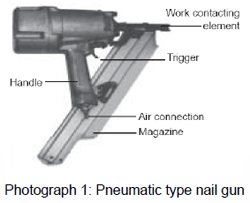Nail guns
Like all power tools, nail guns can be dangerous. The power generated by a nail gun can drive a nail through human bone.
All workers who use nail guns should be trained in their safe use.
Training should address the safe operation of the nail gun, personal protective equipment (PPE) requirements and any other specific directions as stated in the manufacturer's manual. More information on safe usage may also be available from training organisations, industry associations or manufacturers.
Maintain your nail guns to ensure correct operation of the actuation mechanism. If any problems occur, have it repaired by a competent person (i.e. authorised agent) or replace it. Do not continue to use a malfunctioning nail gun.
There are many types of portable, hand-held nail guns. They are powered by either:
- electromagnetism
- compressed air—pneumatic
- highly flammable gases—such as butane or propane
- powder actuated—requiring an explosive charge.
Risks with using nail guns
Most injuries from nail guns are caused by the user accidentally striking the gun's muzzle into a part of the body while holding the tool's trigger switch.
These incidents usually involve nail guns with 'contact trip actuation' (also known as 'bump-fire', 'bounce-fire' or 'simultaneous discharge'). This type of gun fires automatically when the muzzle comes into contact with a surface if the trigger is pressed. They are prone to accidental firing due to sensitive spring compression units within the muzzle.

There is a risk of nails penetrating the body:
- by direct contact with the muzzle of a loaded gun
- by deflection, when skewing off a hard surface
- through soft or thin material.
Other people can also accidentally place themselves into positions where they are directly exposed to the projectile path of a nail gun.
These situations have resulted in people being partially or permanently disabled, blinded, and in some cases, killed.
Control or prevention measures
All nail guns
All workers who use any type of nail gun should be trained in how to use it safely. Training should cover:
- the safe operation of the nail gun
- PPE requirements
- any other specific directions as stated in the manufacturer's manual.
When bump-fire guns may be used
Bump-fire nail guns may be used to reduce the risk of musculoskeletal injuries (e.g. strains and sprains) for jobs that involve high volume production and repetitive tasks. When this is the case, safety measures that should be implemented include:
- establishing an appropriate exclusion zone around the nailing operation with specially laid out work areas and jigs to hold the work pieces in place
- placing signage to alert people that a nailing tool is in use
- reassigning workers not directly involved in the nailing work away from the area where the nailing operation is taking place
- ensuring users and other workers at risk wear appropriate eye and hearing protection and any additional personal protective equipment (PPE) as specified within the user's manual and comply with all work site rules.
When bump-fire guns must not be used
Bump-fire nail guns, including those fitted with switchable levers that allow the gun to be used in another mode, must not be used:
- where the user is required to climb ladders or other elevated areas with a loaded gun
- in restricted and tight spaces where the gun's muzzle could be bumped
- where other people could come within the nail gun's firing path, or there is a foreseeable risk of being struck by a flying nail (e.g. by ricochet or deflection).
Bump-fire type nail guns should only be used under the strictest of controls. Sequential firing mechanisms are a safer option. Nail guns with sequential firing mechanisms are preferred.